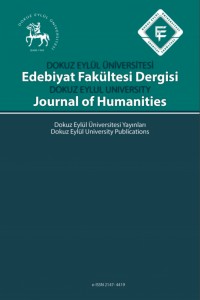Öz
This article aims to discuss the relationship between the unconscious phantasy and the similar elements in popular fictional hero figures. It is claimed that the similar elements are a result of shared unconscious phantasies that are shared widely. Article begins with an introduction to unconscious phantasy and its function in relation to Freudian psychoanalysis. Then basic hero patterns, limited to the type and the quality of the hero figure, are given in a brief discussion to depict the similarities in fictional hero figures. In the last part brief examples are discussed and a perspective on the unconscious phantasy application in relation to the popular fictional hero figures is proposed.
Anahtar Kelimeler
Kaynakça
- Akkurt, B. (2014). The Journey of the hero; patterns, symbols and unconscious fantasy. Yeditepe University, English Language and Literature. İstanbul: Yeditepe Üniversitesi. Retrieved from https://tez.yok.gov.tr/UlusalTezMerkezi/tezSorguSonucYeni. 01. 10. 2019.
- Arlow, J. (2008). The unconscious fantasy and disturbances of conscious experience. Psychoanalytic Quarterly 15, 190-206.
- Beres, D. (1962). The unconscious fantasy. Psychoanalytical Quarterly 31, 309-328.
- Campbell, J. (2004). The Hero with a Thousand Faces. New Jersey. Princeton University Press
- Doniger, W. (1998). The implied spider: Politics and theology in myth. New York. Columbia University Press.
- Dundes, A., and Edmunds, L. (Ed.). (1995). Oedipus: A folklore casebook. Wisconsin. University of Wisconsin Press.
- Dundes, A., Rank, O., Raglan, L., and Segal, R. (1990). In quest of the hero. New Jersey. Princeton University Press.
- Freud, S. (1908). Creative writers and day-dreaming. Freud Collected Papers Vol. 4 (419-428). London. Hogarth and Institute of Psycho-Analysis.
- Freud, A. (1946). The ego and the mechanisms of defense. Oxford. International Universities Press.
- Freud, S. (1959). Family romances. The standard edition of the complete psychological works of Sigmund Freud. Volume IX (1906-1908), Jensen's Gradiva and other works (235-242), London. Hogarth Press and the Institute of Psycho-Analysis.
- Frye, N. (1951). The archetypes of literature. Kenyon Review, 92-110.
- Klapp, O. (1949). The folk hero. The Journal of American Folklore, 62 (243), 17-25.
- Klapp, O. (1954). The clever hero. The Journal of American Folklore, 67 (263), 21-34.
- Klein, M., Heimann, P., Isaacs, S., and Riviere, J. (2002). Developments in psychoanalysis. London. Karnac Books Ltd.
- Raglan, L. (2003). The hero: A study in myth and drama. New York. Dover Publications.
- Rank, O. (2004). The myth of the birth of the hero. New York. The Johns Hopkins University Press.
Öz
Bu çalışma popular kurgusal kahraman figürlerinin paylaştığı temel olguları bilinçdışı fantezi kuramı çerçevesinde incelemeyi amaçlamaktadır. Çalışmanın ilk kısmında bilinçdışı fantezi kuramı ve insan hayatındaki fonksiyonu temel olarak ele alınmaktadır. İkinci kısımda kurgusal kahraman figürlerinin ortak özellikleri, kahraman figürünün niteliği ve karakteristiği odaklı bir şekilde, Freud temelli psikanaliz çerçevesinde ele alınmaktadır. Son kısımda örnekler kısaca tartışılmakta ve bilinçdışı fantezi kuramının popüler kurgusal kahraman figürleri ile birlikte kullanımı hakkında bir bakış açısı sunulmaktadır.
Anahtar Kelimeler
bilinçdışı fantez freud klapp kahraman tipleri kurgusal kahraman
Kaynakça
- Akkurt, B. (2014). The Journey of the hero; patterns, symbols and unconscious fantasy. Yeditepe University, English Language and Literature. İstanbul: Yeditepe Üniversitesi. Retrieved from https://tez.yok.gov.tr/UlusalTezMerkezi/tezSorguSonucYeni. 01. 10. 2019.
- Arlow, J. (2008). The unconscious fantasy and disturbances of conscious experience. Psychoanalytic Quarterly 15, 190-206.
- Beres, D. (1962). The unconscious fantasy. Psychoanalytical Quarterly 31, 309-328.
- Campbell, J. (2004). The Hero with a Thousand Faces. New Jersey. Princeton University Press
- Doniger, W. (1998). The implied spider: Politics and theology in myth. New York. Columbia University Press.
- Dundes, A., and Edmunds, L. (Ed.). (1995). Oedipus: A folklore casebook. Wisconsin. University of Wisconsin Press.
- Dundes, A., Rank, O., Raglan, L., and Segal, R. (1990). In quest of the hero. New Jersey. Princeton University Press.
- Freud, S. (1908). Creative writers and day-dreaming. Freud Collected Papers Vol. 4 (419-428). London. Hogarth and Institute of Psycho-Analysis.
- Freud, A. (1946). The ego and the mechanisms of defense. Oxford. International Universities Press.
- Freud, S. (1959). Family romances. The standard edition of the complete psychological works of Sigmund Freud. Volume IX (1906-1908), Jensen's Gradiva and other works (235-242), London. Hogarth Press and the Institute of Psycho-Analysis.
- Frye, N. (1951). The archetypes of literature. Kenyon Review, 92-110.
- Klapp, O. (1949). The folk hero. The Journal of American Folklore, 62 (243), 17-25.
- Klapp, O. (1954). The clever hero. The Journal of American Folklore, 67 (263), 21-34.
- Klein, M., Heimann, P., Isaacs, S., and Riviere, J. (2002). Developments in psychoanalysis. London. Karnac Books Ltd.
- Raglan, L. (2003). The hero: A study in myth and drama. New York. Dover Publications.
- Rank, O. (2004). The myth of the birth of the hero. New York. The Johns Hopkins University Press.
Ayrıntılar
| Birincil Dil | İngilizce |
|---|---|
| Bölüm | Makaleler |
| Yazarlar | |
| Yayımlanma Tarihi | 23 Nisan 2021 |
| Gönderilme Tarihi | 17 Haziran 2020 |
| Yayımlandığı Sayı | Yıl 2021 Cilt: 8 Sayı: 1 |


